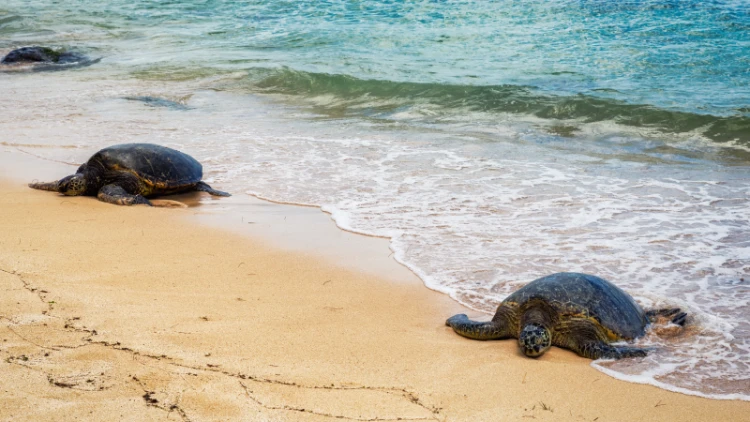The Andaman and Nicobar Islands are not just a tropical paradise for beach lovers; they are also a crucial habitat for sea turtles. Every year, thousands of sea turtles return to the islands’ beaches to lay their eggs, making it a unique and magical experience for wildlife enthusiasts. However, with increasing tourism, it’s essential to visit these nesting sites responsibly to protect these endangered species. In this comprehensive guide, I’ll take you through the top turtle nesting sites in Andaman, tips for responsible tourism, and my personal experiences. Let’s dive in!
Why Are Turtle Nesting Sites Important?
Sea turtles play a vital role in maintaining the health of marine ecosystems. They help control jellyfish populations, maintain seagrass beds, and contribute to nutrient cycling. However, sea turtles are endangered due to habitat destruction, pollution, and climate change. Protecting their nesting sites is crucial for their survival.
Top Turtle Nesting Sites in Andaman
Here are some of the top turtle nesting sites in Andaman that you shouldn’t miss:
1. Galathea Bay, Great Nicobar Island
Galathea Bay is one of the most important nesting sites for leatherback turtles in the Andaman and Nicobar Islands. The bay is part of the Great Nicobar Biosphere Reserve and offers a pristine environment for turtle nesting.
Key Features:
- Species: Leatherback turtles.
- Nesting Season: December to March.
- Conservation Efforts: The area is protected, and visitors are required to follow strict guidelines.
- How to Reach: Accessible by boat from Port Blair.
My Experience:
Visiting Galathea Bay was a surreal experience. The sight of leatherback turtles coming ashore to lay their eggs was unforgettable. The conservation efforts in place ensured that the turtles were not disturbed, and I felt privileged to witness this natural phenomenon.
2. Cuthbert Bay, Middle Andaman
Cuthbert Bay is another important nesting site for sea turtles, including olive ridley and green turtles. The bay is part of the Cuthbert Bay Wildlife Sanctuary and offers a serene environment for turtle nesting.
Key Features:
- Species: Olive ridley and green turtles.
- Nesting Season: January to April.
- Conservation Efforts: The sanctuary has strict guidelines to protect the nesting turtles.
- How to Reach: Accessible by road from Port Blair.
My Experience:
Cuthbert Bay was a peaceful and serene destination. The olive ridley turtles were a delight to watch, and the sanctuary’s efforts to protect them were commendable. The guided tours provided valuable insights into the turtles’ behavior and conservation efforts.
3. Ross and Smith Islands
Ross and Smith Islands, located near Diglipur, are known for their beautiful beaches and turtle nesting sites. The islands are a popular destination for eco-tourists and offer a unique opportunity to witness turtle nesting.
Key Features:
- Species: Olive ridley and green turtles.
- Nesting Season: December to February.
- Conservation Efforts: The islands are part of a protected area, and visitors are required to follow guidelines.
- How to Reach: Accessible by boat from Diglipur.
My Experience:
Ross and Smith Islands were a hidden gem. The beaches were pristine, and the turtle nesting experience was magical. The conservation efforts ensured that the turtles were not disturbed, and I felt good knowing that my visit was supporting sustainable tourism.
Tips for Responsible Tourism at Turtle Nesting Sites
Here are some tips to help you visit turtle nesting sites responsibly:
- Follow Guidelines: Always follow the guidelines provided by the sanctuary or tour operator. Do not disturb the turtles or their nests.
- Keep a Safe Distance: Maintain a safe distance from the turtles and avoid using flash photography.
- Minimize Waste: Carry reusable water bottles and avoid single-use plastics. Dispose of waste properly.
- Support Local Communities: Choose eco-friendly accommodations and support local businesses.
- Educate Yourself: Learn about the turtles’ behavior and conservation efforts before your visit.
My Personal Experience
During my trip to Andaman, I made it a point to visit turtle nesting sites responsibly. The experience was incredibly rewarding, and I felt good knowing that my visit was contributing to the conservation of these endangered species. From the leatherback turtles at Galathea Bay to the olive ridley turtles at Cuthbert Bay, each site offered a unique and unforgettable experience.
Frequently Asked Questions (FAQs)
1. What is the best time to visit turtle nesting sites in Andaman?
The best time to visit turtle nesting sites in Andaman is during the nesting season, which typically runs from December to April.
2. Can I touch the turtles or their eggs?
No, it is strictly prohibited to touch the turtles or their eggs. Always follow the guidelines provided by the sanctuary or tour operator.
3. Are there any entry fees for turtle nesting sites?
Some turtle nesting sites may have entry fees, which are used for conservation efforts. It’s best to check with the sanctuary or tour operator before your visit.
4. How can I support turtle conservation efforts in Andaman?
You can support turtle conservation efforts by visiting responsibly, supporting local communities, and donating to conservation organizations.
Conclusion
Visiting turtle nesting sites in Andaman is a unique and magical experience, but it’s crucial to do so responsibly. By following guidelines, minimizing waste, and supporting local communities, you can help protect these endangered species and their habitats. So, plan your trip, visit responsibly, and get ready to witness the wonders of nature in Andaman!
References:

